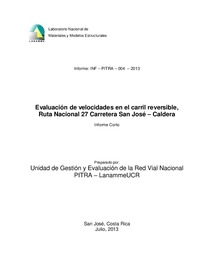EVALUACIÓN DE VELOCIDADES EN EL CARRIL REVERSIBLE, RUTA NACIONAL 27 CARRETERA SAN JOSÉ – CALDERA

View/
Date
2013-07Author
Garro Mora, José Francisco
Naranjo Ureña, Ronald
Valverde Cordero, Christian
Sanabria Sandino, Jairo
Barrantes Jiménez, Roy
Loría Salazar, Luis Guillermo
Metadata
Show full item recordAbstract
La implementación del carril reversible en la Ruta Nacional 27 Carretera San José – Caldera, permite aumentar de manera temporal la capacidad del tramo comprendido entre el peaje de Pozón y el de Ciudad Colón, el cual presenta en la mayor parte de su longitud sólo 1 carril por sentido. Sin embargo, como la infraestructura de la ruta no está prevista para este tipo de solución, la cual se da de manera rutinaria, se expone a los usuarios a niveles de seguridad vial no aptos para la circulación a alta velocidad. Del estudio que se realizó en 3 puntos, se demuestra que la velocidad de operación supera en 20 kph la señalizada como máxima, lo cual a falta de controles de las autoridades, aumenta la probabilidad de accidentes fatales en dicha ruta. The implementation of the reversible lane on the National Route 27 Highway San José - Caldera, allows to temporarily increase the capacity of the section between the toll Pozón and the one in Ciudad Colón, which features in most of its length just 1 lane on each direction. However, as the infrastructure of the route is not foreseen for this type of solution, which is given routinely, users are exposed to levels of road safety that are not suitable for circulation at high speed.
From the study that was performed in 3 points, it is shown that the operating speed exceeds on 20 kph the indicated as maximum, which in the absence of controls by the authorities, increases the possibility of fatal accidents on that route.
Collections
- Informes [1102]
